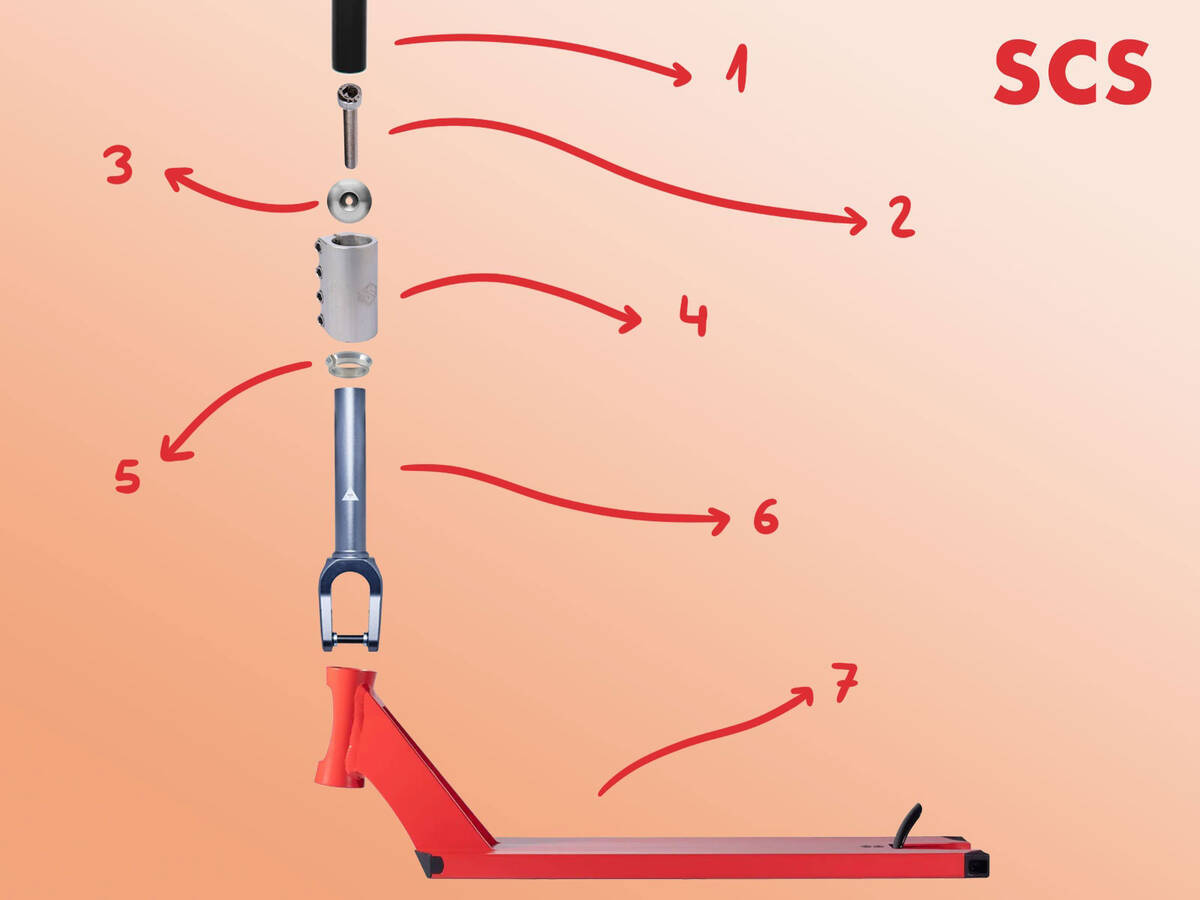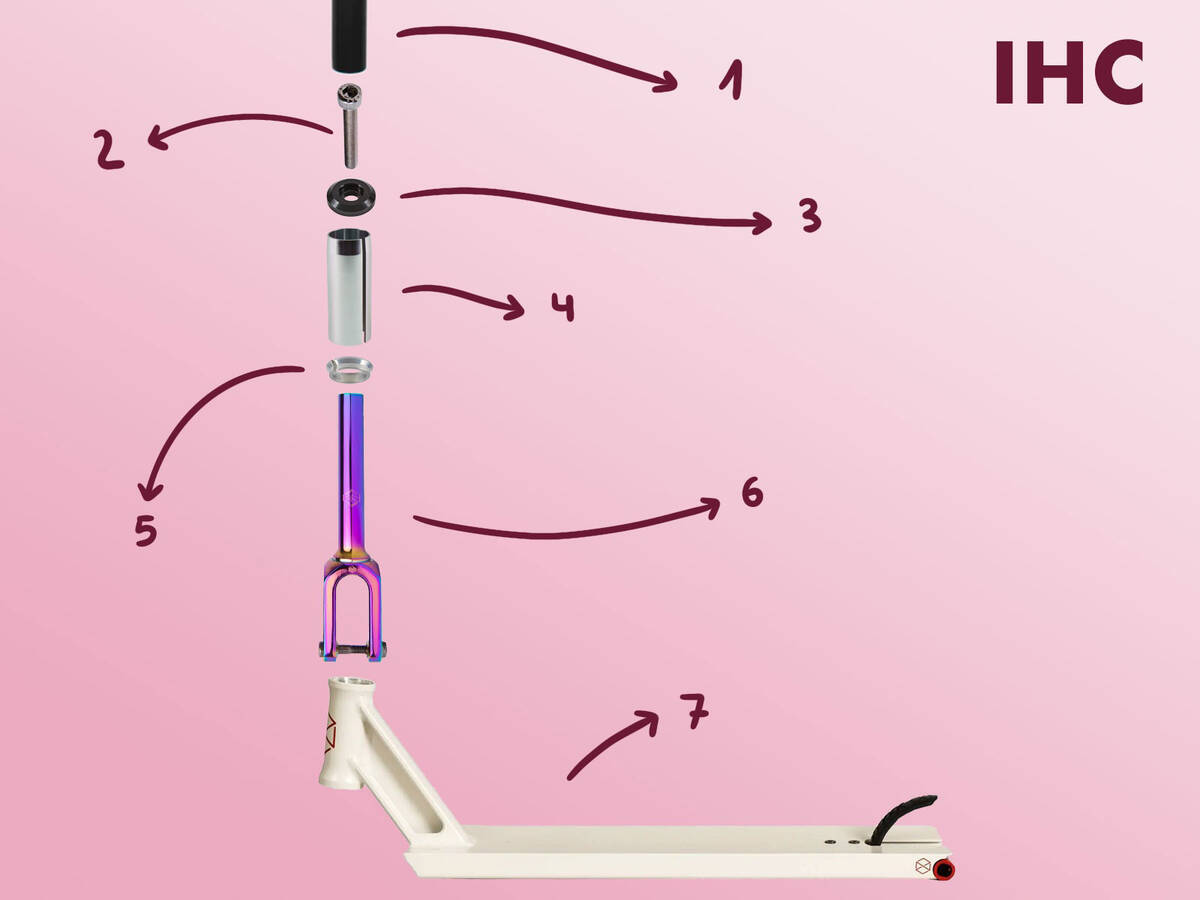Scooter Compression Overview

The compression system in a pro scooter is crucial to your setup. It ensures the secure attachment between the handlebars, headset, and fork. Whether you're just starting out or are a more seasoned scooter enthusiast seeking a new compression kit, this guide is designed to educate you on the fundamental aspects of pro scooter compression systems.
We'll delve into the advantages and disadvantages of the most prevalent compression systems, examining their adaptability with various scooter components. By the conclusion, you'll be equipped to decide on the ideal type of compression for your needs and maximise the performance of your pro scooter.
SCS Compression

1: Bar (no slit) 2: Compression Bolt 3: Top Cap 4: SCS Clamp 5: C-Ring 6: Fork 7: Deck (headtube & headset)
The Standard Compression System, or SCS, is praised for its durability and straightforward design, making it ideal for intense use. While SCS adds a bit of weight, it remains the most resilient compression option, compatible with both standard and oversized bars.
Steps for SCS Compression Installation
This system involves connecting the clamp to the fork with an internal compression bolt that uses a top cap to exert pressure against the clamp's interior edge. The compression bolt is secured into a starnut or integrated thread in the fork (modern SCS forks usually have built-in threads). The bar is held steady by the clamp, which is fastened with four bolts.
To see the installation process for SCS compression, watch the video below:
Compatible Bars for SCS
Bars without a slit at the base are necessary for an SCS setup; a slit would compromise integrity as the clamp would squeeze it. Bars can be modified to remove the slit, or use a suitable SCS bar adapter.
Compatible Clamps for SCS
An SCS clamp is required because the compression system is integrated within it. Ensure the clamp's inner diameter aligns with your bars' outer diameter—either the standard 32 mm or the oversized 35 mm.
Notice: If the interior edge of the SCS clamp does not surpass the top of the fork, a secure clamp-to-fork connection cannot be achieved. Correct this with a headset spacer to elevate the clamp's position.
Compatible Forks for SCS
Forks designed for both HIC and SCS systems are suitable for SCS compression.
HIC Compression

1. Bar 2. Compression Bolt 3. Top Cap 4. IHC Shim 5. C-Ring 6. Fork 7. Deck (headtube & headset)
The abbreviation HIC stands for Hidden Internal Compression. Although it's not the lightest option, HIC's relative simplicity and lighter weight than SCS make it appealing. However, it needs a bar with a bottom slit, a potential weak point absent in SCS.
Steps for HIC Compression Installation
This involves positioning an HIC shim on the fork, with a compression bolt and top cap pressing the shim against the scooter deck's headtube to secure the fork. The bar is tightened around the fork tube with a clamp.
To view how HIC compression parts are assembled, watch the following video:
HIC-Compatible Bars
HIC-compatible bars should have a 32 mm inner diameter and 35 mm outer diameter, generally constructed from sturdy materials like steel or titanium. Aluminium bars won't work due to their thicker tubing requirements, while HIC bars must include a bottom slit.
HIC-Compatible Clamps
The clamp for your HIC setup should cover the slit fully and maintain a 35 mm (oversized) inner diameter.
HIC-Compatible Forks
Forks designed for both HIC and SCS are suitable for HIC compression.
Note: To properly compress, fit an HIC spacer before the shim to enhance your setup’s efficiency.
IHC Compression

1. Bar 2. Compression Bolt 3. Top Cap 4. IHC Shim 5. C-Ring 6. Fork 7. Deck (headtube & headset)
Internal Hidden Compression, or IHC, is akin to HIC while offering a lighter assembly and reliable compression.
The main difference is that IHC forks have a narrower shaft, allowing them to fit with bars having a 28 mm inner diameter, such as aluminium bars with a 28 mm inner and 35 mm outer diameter.
Steps for IHC Compression Installation
An IHC compression ring sits within the headset bearing to support the narrower fork tube, avoiding any unwanted movement between the fork and bearing.
Next, mount the IHC shim on the fork tube, place a top cap above the shim, and insert the compression bolt into the threaded fork. Proper tightening ensures compression by pressing down on the top cap.
Check out how to mount IHC compression in the video below:
IHC-Compatible Bars
IHC can accommodate any bar with a 28 mm (standard) inner diameter and a bottom slit.
For using oversized steel or titanium bars with IHC forks, an adapter is needed for the larger inner diameter.
IHC-Compatible Clamps
Ensure your clamp's inner diameter matches the outer diameter of your chosen bar.
IHC-Compatible Forks
Specific IHC forks are tailor-made for IHC compression, featuring lighter shafts. They fit perfectly with bars with a regular 28 mm inner diameter.
Note: The proper extension of the IHC shim beyond the fork tube's end protruding from the headtube is crucial; otherwise, use a headset spacer for secure compression.
ICS Compression
Inverted/Internal Compression System (ICS) is known for being lightweight and affordable, requiring minimal parts to assemble.
However, installation and upkeep can be tricky. Though lightweight construction may be favoured by park riders, ICS lacks the robustness of SCS.
Steps for ICS Compression Installation
In ICS, a bolt is inserted through the fork from below, secured by a star nut within the bar. ICS comprises the fewest components out of other systems.
Installation and maintenance can be burdensome; the front wheel must be removed to adjust the bolt. For instance, bar removal necessitates front-wheel removal and complete loosening of the compression bolt.
Watch the ICS compression installation in the following video:
Bars for ICS Compression
The compression depends on a star nut fitting securely inside the bar. Steel and titanium bars can become loose due to their hard and smooth surfaces; aluminium bars hold the star nut more securely.
For ICS, either use an aluminium bar or a bar with a permanently fitted star nut.
ICS bars generally feature a 28 mm inner diameter with a slit at the base, similar to IHC and HIC bars. Ensure your clamp matches the outer diameter, which can range from 32 mm to 35 mm.
ICS-10 Compression
The ICS-10 system closely resembles standard ICS, with the only difference being the thread size of the compression bolt.
ICS-10 utilises an M10 thread, while typical ICS uses M6 threads, making the thicker bolt slightly more durable.
Watch the installation of ICS-10 compression in this video:
Compression Systems Video Explanation
Explore this detailed explanation video featuring in-depth insights on scooter compression, including SCS, HIC, IHC, and ICS-10 systems.
